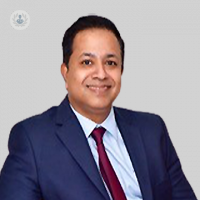TMJ disorder: A guide for patients
Escrito por:In his latest online article, leading consultant oral and maxillofacial surgeon Mr Anwer Abdullakutty delves into TMJ disorder. He explains what this disorder is, the symptoms, diagnosis and the different types of treatment.

What is TMJ disorder?
TMJ disorder comprises a group of disorders, and that's what I convey to my patients. It can affect not only the joint itself but also the associated bones, muscles, and nerves. Essentially, it represents a spectrum of disorders. Jaw joint problems can be categorised as joint and muscular problems, specifically myofascial problems. In my clinical practice, the predominant presentation is often muscular, commonly known as myofascial pain.
What are the symptoms of TMJ disorder?
Symptoms vary due to the multifaceted nature of TMJ disorder. Individuals may experience difficulty opening their mouth, pain, ear discomfort due to proximity, or even a clicking noise. In advanced stages, a person may face a restricted joint, leading to problems like difficulty eating or chewing, an inability to yawn properly, and, depending on the stage, symptoms such as numbness or a ringing sensation in the ear may arise.
What can cause TMJ disorder?
Several factors contribute to TMJ disorder. Commonly, abnormal muscle movements like clenching and grinding, known as bruxism, are key factors. This often occurs at night (nocturnal bruxism). Habits like excessive chewing gum use or nail biting also play a role. Joint trauma, such as injury to the lower jaw, infections in the teeth or ears, and dental discrepancies like a misaligned bite, can contribute to the disorder.
How can it be diagnosed?
Diagnosing this complex problem involves a comprehensive approach. Initial assessment through conversation with the patient to understand their main issues, symptoms, and signs is crucial. Clinical examination helps in provisional diagnosis, and additional tests, such as MRI scans and x-rays, are performed to rule out dental causes. Specialized procedures like arthroscopy can differentiate between muscular and joint problems, guiding the appropriate course of action.
Are there any treatments available for this disorder?
Various treatments are available, ranging from simple to complex. Initial steps include reassurance and patient education to address causative factors that can be stopped. Diagnostic procedures, like arthroscopy, help alleviate pain-related issues in the joint. Addressing teeth problems is crucial before considering surgical interventions. While surgical treatments are available, TMJ problems often have a self-limiting nature. Non-invasive approaches, such as reassurance, patient education, and breaking harmful habits, are typically effective in resolving the issue without resorting to surgery.
Mr Anwer Abdullakutty is a renowned dual-qualified surgeon in both medicine and dentistry. If you would like to book a consultation with Mr Abdullakutty, you can do so today via his Top Doctors profile.


